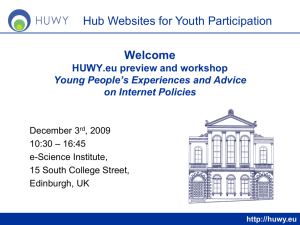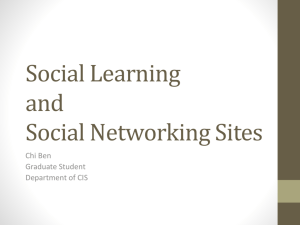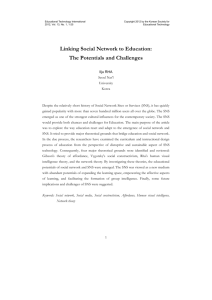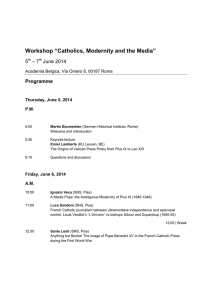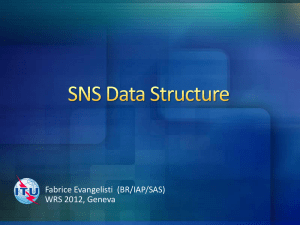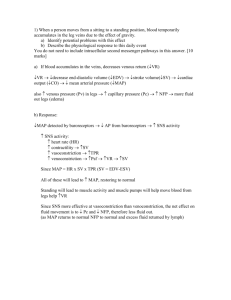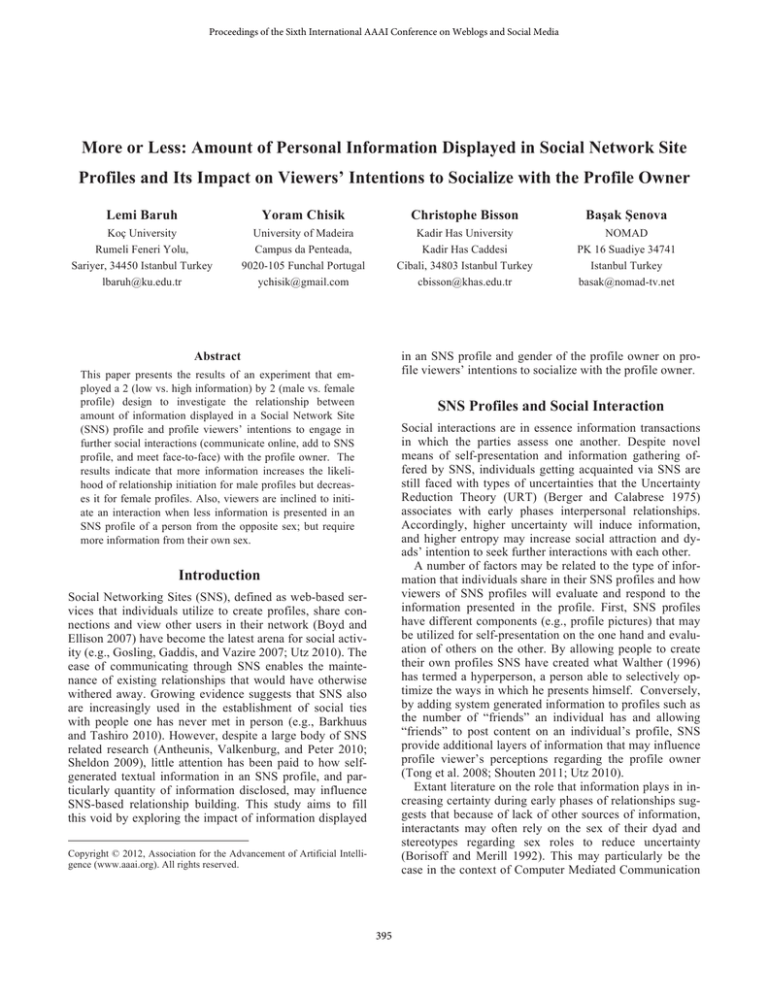
Proceedings of the Sixth International AAAI Conference on Weblogs and Social Media
More or Less: Amount of Personal Information Displayed in Social Network Site
Profiles and Its Impact on Viewers’ Intentions to Socialize with the Profile Owner
Lemi Baruh
Yoram Chisik
Christophe Bisson
Başak Şenova
Koç University
Rumeli Feneri Yolu,
Sariyer, 34450 Istanbul Turkey
lbaruh@ku.edu.tr
University of Madeira
Campus da Penteada,
9020-105 Funchal Portugal
ychisik@gmail.com
Kadir Has University
Kadir Has Caddesi
Cibali, 34803 Istanbul Turkey
cbisson@khas.edu.tr
NOMAD
PK 16 Suadiye 34741
Istanbul Turkey
basak@nomad-tv.net
in an SNS profile and gender of the profile owner on profile viewers’ intentions to socialize with the profile owner.
Abstract
This paper presents the results of an experiment that employed a 2 (low vs. high information) by 2 (male vs. female
profile) design to investigate the relationship between
amount of information displayed in a Social Network Site
(SNS) profile and profile viewers’ intentions to engage in
further social interactions (communicate online, add to SNS
profile, and meet face-to-face) with the profile owner. The
results indicate that more information increases the likelihood of relationship initiation for male profiles but decreases it for female profiles. Also, viewers are inclined to initiate an interaction when less information is presented in an
SNS profile of a person from the opposite sex; but require
more information from their own sex.
SNS Profiles and Social Interaction
Social interactions are in essence information transactions
in which the parties assess one another. Despite novel
means of self-presentation and information gathering offered by SNS, individuals getting acquainted via SNS are
still faced with types of uncertainties that the Uncertainty
Reduction Theory (URT) (Berger and Calabrese 1975)
associates with early phases interpersonal relationships.
Accordingly, higher uncertainty will induce information,
and higher entropy may increase social attraction and dyads’ intention to seek further interactions with each other.
A number of factors may be related to the type of information that individuals share in their SNS profiles and how
viewers of SNS profiles will evaluate and respond to the
information presented in the profile. First, SNS profiles
have different components (e.g., profile pictures) that may
be utilized for self-presentation on the one hand and evaluation of others on the other. By allowing people to create
their own profiles SNS have created what Walther (1996)
has termed a hyperperson, a person able to selectively optimize the ways in which he presents himself. Conversely,
by adding system generated information to profiles such as
the number of “friends” an individual has and allowing
“friends” to post content on an individual’s profile, SNS
provide additional layers of information that may influence
profile viewer’s perceptions regarding the profile owner
(Tong et al. 2008; Shouten 2011; Utz 2010).
Extant literature on the role that information plays in increasing certainty during early phases of relationships suggests that because of lack of other sources of information,
interactants may often rely on the sex of their dyad and
stereotypes regarding sex roles to reduce uncertainty
(Borisoff and Merill 1992). This may particularly be the
case in the context of Computer Mediated Communication
Introduction
Social Networking Sites (SNS), defined as web-based services that individuals utilize to create profiles, share connections and view other users in their network (Boyd and
Ellison 2007) have become the latest arena for social activity (e.g., Gosling, Gaddis, and Vazire 2007; Utz 2010). The
ease of communicating through SNS enables the maintenance of existing relationships that would have otherwise
withered away. Growing evidence suggests that SNS also
are increasingly used in the establishment of social ties
with people one has never met in person (e.g., Barkhuus
and Tashiro 2010). However, despite a large body of SNS
related research (Antheunis, Valkenburg, and Peter 2010;
Sheldon 2009), little attention has been paid to how selfgenerated textual information in an SNS profile, and particularly quantity of information disclosed, may influence
SNS-based relationship building. This study aims to fill
this void by exploring the impact of information displayed
Copyright © 2012, Association for the Advancement of Artificial Intelligence (www.aaai.org). All rights reserved.
395
(CMC), within which the lack of individuating information
may lead to a heightened reliance on information provided
by category cues such as sex (Lee 2004). Sex differences
and biases in information sharing are well documented in
the literature. A number of studies indicate that conventional sex schema associates proclivity to intimacy with
women (e.g., Lease et al. 2010). Hence, men who share
“too much” may be considered as less well-adjusted and
consequently less viable as a potential dyad. On the other
hand, in early stages of relationships, men are expected to
assume an agentic role by initiating relationships, which,
within the context of SNS, can mostly be achieved by sharing information via a profile.
The nature of the relationships being established over
SNS is also a factor that may influence the information
expectations of interactants. For example, dyad gender
structure (same sex vs. opposite sex) have been found to be
a factor that influences information seeking and sharing
behavior in early phases of face-to-face relationships
(McKinney and Donaghy, 1993). However, to our
knowledge, dyadic gender structure has received hardly
any attention within the context of SNS.
ther social interactions with the profile owner, the study
employed a 2 (low info. amount vs. high info. amount) X 2
(male vs. female profile) replicated design: for each condition (e.g. male-high information, male-low information),
four different profile versions were created, resulting in 16
profiles. Such replicated designs help address validity
threats such as case-category confounding (Jackson, 1992).
In order to create the amount of information (low vs.
high) condition, first a list of information items were compiled from actual SNS profiles. Then, the “low amount of
information” condition was created by randomly selecting
20 information items from the list. The “high amount of
information condition” was created by adding 10 randomly
selected items to the “low amount of information” condition. Profile gender was manipulated by varying the gender
of the avatar and the content of gender specific information
items (e.g. name of spouse).
During the experiment, the respondents were first presented with one SNS profile randomly selected from the 16
profiles and then were directed to a questionnaire regarding
the SNS profile they had just viewed. Intention to engage
in further social interactions with the profile owner were
measured by asking the respondents to rate on a sevenpoint scale (1 = very unlikely to 7 = very likely), the likelihood that they would “communicate online” (M = 2.19;
SD = 1.57), “add this person as a friend in your social network profile” (M = 2.17; SD = 1.59), and “arrange a faceto-face meeting” (M = 1.72; SD = 1.29).
Using the profile sex (male vs. female) and respondents’
self-reported sex (male vs. female), the dyad gender structure was computed as same sex (e.g., male profile-male
viewer) vs. opposite sex (e.g., male profile-female viewer).
Research Questions
RQ1: How does amount of information shared in an SNS
profile, gender of the profile and dyadic gender structure
(same vs. opposite) influence viewers' intentions to a)
communicate online with the profile owner; b) add the
profile owner to the SNS friends' list; c) arrange face-toface meeting with the profile owner.
RQ2: How does profile gender moderate the relationship
between amount of information shared in a profile and
viewers’ intentions to a) communicate online with the profile owner; b) add the profile owner to the SNS friends' list;
c) arrange face-to-face meeting with the profile owner.
RQ3: How does dyad gender structure moderate the relationship between amount of information shared in a profile
and viewers' intentions to a) communicate online with the
profile owner; b) add the profile owner to the SNS friends'
list; c) arrange face-to-face meeting with the profile owner.
Results
Prior to the hypothesis tests, a manipulation check, performed using a five-point scale asking the respondents to
rate the amount of information profile owner revealed (1 =
“far too little” to 5 = “far too much”), confirmed that when
compared to participants in the low information condition
(M = 3.43, SD = 1.05) participants in the high information
condition (M = 3.73, SD = 1.02) reported seeing more information (F (1, 1035) = 22.140, p <0.001)).
The hypotheses were tested using a MANOVA with the
linear combination of the three intention variables (“communicate online”, “add to SNS friends’ list”, and “meet
face-to-face”) as the dependent variable. This was followed
by ANOVA tests for each dependent variable (with Bonferroni adjustment for multiple comparisons).
The first research question (RQ1) focused on the impact
of amount of information, profile sex, and dyad gender
structure on intentions for further social interaction with
profile owner. In the MANOVA analysis, there was no
significant omnibus effect for amount of information disclosed (Wilks’ Λ = .998, F (3, 1007) = .798, p = .495 with
partial η2 = .002). or for dyad gender structure (Wilks’ Λ =
1.000, F (3, 1007) =.147, p = .932 with partial η2 = .000).
On the other hand, there was a significant omnibus ef-
Method
This study was carried out as part of the Time-sharing Experiments for the Social Sciences (TESS) project. Participants were sampled randomly from a list of active panel
members of the Knowledge Networks, Inc., which recruits
a random sample of the general U.S. population to administer online studies. The current study had a response rate
of 69% (n = 1059). After data collection, a poststratification weighting procedure, which utilized demographic distributions from the U.S. Current Population
Survey (CPS) as the benchmark, was applied. The respondents’ mean age was 47 (SD = 16.76) and slightly
more than half were female (52%).
To test the relationship between amount of information
in an SNS profile and viewers’ intention to engage in fur-
396
fect for profile gender (Wilks’ Λ = .982, F (3, 1007) =
6.318, p < .001 with partial η 2 = .018). Accordingly, respondents were more likely to want to communicate online
(F (1, 1009) = 5.229, p < .05) and meet face-to-face (F (1,
1009) = 10.448, p < .001) with female profile owners.
The second research question (RQ2) pertains to the interaction between amount of information shared in an SNS
profile and profile owner’s sex as a predictor of intention
to engage in further social interactions with the profile
owner. The MANOVA analysis shows an omnibus effect
of the interaction between amount of information and profile gender (Wilks’ Λ = .986, F (3, 1007) = 4.598, p < .01
with partial η2 = .014). Separate ANOVA tests showed
that the interaction between information amount and profile gender approached significance for intentions to communicate online (F (1, 1009) = 3.065, p = .08) and to add
profile owner to SNS friends’ list (F (1, 1009) = 3.655, p =
.056) and was significant for intentions to meet face-toface with profile owner (F (1, 1009) = 12.02, p < .001).
Whereas for male profiles, higher amount of information
led to higher reported intentions to pursue further social
interactions with the profile owner, for female profiles,
more information led to lower intentions to engage in social further interactions with the profile owner (Figure 1).
Figure 2: Info. Amount by Gender Structure Interaction
Discussion and Conclusion
Overall the results point to a complex set of interactions
at play fuelled by stereotypical gender expectations and
emerging patterns of SNS use. The MANOVA analyses
revealed two significant two-way interactions.
The first of these was between amount of information on
an SNS profile and gender of the profile owner. The results
suggest that for female profiles, which elicited higher
overall intentions for further interactions, more information
led to lower intentions to pursue further social interactions.
However, for male profiles, more information led to higher
intentions. These results may sound counterintuitive at first
because existing literature on relationship formation states
that people often associate proclivity to self-disclosure
with women (Consedine, Sabag-Cohen, and Krivoshekova
2007). Consequently, too much sharing of information by
men may be considered as a violation of gendered
expectations about intimacy and may adversely affect the
prospects of further socialization. However, the findings
from this study are in line with previous research
indicating that men may be expected to take charge to
initiate relationships (Derlega, Winstead, and Greene
2008), which, in the context of SNS, can be done by
sharing information. Also, the finding that viewers are
more likely to interact with female profiles that contain
less information is in line with reseach suggesting that in
early stages of relationships women who tell rather than
ask are considered to be promiscuous (Lindsey and Zakahi
1996).
The second key interaction was between amount of information in a profile and dyad gender structure (same-sex
vs. opposite sex). Accordingly, more information in a profile led to higher intention to engage in further social interactions with profile owner for same-sex profile but lower
intentions for opposite-sex profiles. This finding is congruent with research suggesting that in the case of oppositesex profiles the interest in the profile may be fuelled by
curiosity or romantic intent (Bryant, Marmo, and Ramirez
2010). As such, less information in the profile of individuals from opposite sex may peak curiosity and instigate a
desire for further socialization (Norton, Frost, and Ariely
2007). On the other hand, for same-sex profile viewing,
social browsing (i.e., searching for profiles simply to learn
more about them) (Lampe, Ellison, and Steinfeld 2006)
Figure 1: Info. Amount by Profile Gender Interaction
The third research question (RQ3) focused on the interaction between information amount and the dyad gender
structure as a potential predictor of viewers’ intention to
engage in additional social interactions with the profile
owners (Figure 2). There was a significant omnibus effect
for the two-way interaction between amount of information
and dyad gender structure, Wilks Λ = .989, F (3, 1007) =
3.655, p < .05 with partial η2 = .011.
Subsequent ANOVA tests showed the interaction was
significant for all three of the dependent variables—
communicate online (F (1, 1009) = 8.261, p < .01), add to
SNS friends’ list (F (1, 1009) = 10.25, p < .001), and meet
face-to-face (F (1, 1009) = 8.14, p < .01). For same-sex
profiles, more information increased respondents’ intention
to communicate online, add profile owner to SNS friends’
list, and arrange to meet face-to-face. On the other hand,
for opposite-sex profiles, more information decreased respondents’ intention to engage in further social interactions
with the profile owner.
397
and uncertainty reduction may override other considerations and thus higher entropy may lead to a greater “liking”
and a stronger intent to socialize.
Researchers (e.g., Boyd and Ellison 2007; Burke, Kraut,
and Marlow 2011) have frequently stressed the need for a
differentiation between types of users, types of SNS platforms (e.g. SNS for professional connections) and types of
uses of SNS. Hence, further research is needed to test the
interpretation provided above by investigating the influence of “more information” on intent to socialize in different SNS contexts, including gaming environments (Cheung
and Huang 2011) and perhaps more significantly SNS sites
for romantic relationship building, and for different SNS
use motivations. Also, further attention needs to be paid to
interactions between amount of information, presence of
other profile elements (e.g., photos), and the type of information shared. Finally, similar studies that investigate real
world reactions (e.g., whether users actually add profiles to
their network in reaction to more or less information)
would make crucial contribution to the study of SNS use
and behavior.
Derlega, V. J.; Winstead, B. A.; and Greene, K. 2008. Self-disclosure and
Starting a Close Relationship. In Sprecher, S.; Wenzel, A.; and Harvey, J.
eds. Handbook of Relationship Beginnings, 153-174. New York:
Psychology Press.
Gosling, S. D., Gaddis, S., and Vazire, S. 2007. Personality Impressions
Based on Facebook Profiles. Proceedings of ICWSM’07, 1-4. Boulder,
Colorado.
Jackson, S. 1992. Message Effects Research Principles of Design and
Analysis. New York: The Guilford Press.
Joinson, A.N. 2008. ‘Looking at’, ‘Looking up’ or ‘Keeping up with’
People? Motives and Uses of Facebook. In Proceedings of CHI’08,10271036. Florence, Italy.
Lampe, C., Ellison, N., and Steinfield, C. 2006. A Face(book) in the
Crowd: Social Searching versus Social Browsing. In Proceedings of
CSCW’06, 167–170. New York.
Lease, S. H.; Hampton, A. B.; Fleming, K. M.; Baggett, L. R.; Montes, S.
H.; and Sawyer, R. J. 2010. Masculinity and Interpersonal Competencies:
Contrasting White and African American Men. Psychology of Men &
Masculinity 11(3): 195-207.
Acknowledgments
Lee, E. J. 2004. Effects of Gendered Character Representation on Person
Perception and Informational Social Influence in Computer-mediated
Communication. Computers in Human Behavior 20(6): 779-799.
Data collected by Time-sharing Experiments for the Social
Sciences, NSF Grant 0818839, Jeremy Freese and Penny
Visser, Principal Investigators.
Lindsey, A. E., and Zakahi, W. R. 1996. Women Who Tell and Men Who
Ask: Perception of Men and Women Departing from Gender Stereotypes
During Initial Interaction. Sex Roles 34(11/12): 767-786.
References
McKinney, D. H., and Donaghy, W. C. 1993. Dyad Gender Structure,
Uncertainty Reduction, and Self-disclosure during Initial Interaction. In
Kalbfleisch, P. J. ed. Interpersonal Communication Evolving Interpersonal Relationships, 33-50. Hillsdale, NJ: Lawrence Erlbaum Associates.
Antheunis M. L.; Valkenburg P. M.; and Peter, J. 2010. Getting
Acquainted Through Social Network Sites: Testing a Model of Online
Uncertainty Reduction and Social Attraction. Computers in Human
Behavior 26(1): 100-109.
Norton, M.; Frost, J.; and D. Ariely. 2007. Less is More: The Lure of
Ambiguity, or Why Familiarity Breeds Contempt. Journal of Personality
and Social Psychology 92(1): 97–105.
Barkhuus, L., and Tashiro, J. 2010. Student Socialization in the Age of
Facebook. In Proceedings of CHI’10, 133-142. Atlanta, Georgia.
Schrammel, J.; Köffel, C.; and Tscheligi, M. 2009. How Much Do You
Tell? Information Disclosure Behaviour in Different Types of Online
Communities. In Proceedings of C&T’09, 275-284. University Park,
Pennsylvania.
Berger, C. R., and Calabrese, R. J. 1975. Some Exploration in Initial
Interaction and Beyond: Toward a Developmental Theory of
Communication. Human Communication Research 1(2): 99–112.
Boyd, D. M., and Ellison, N. B. 2007. Social Network Sites: Definition,
History,
and
Scholarship.
Journal
of
Computer-Mediated
Communication 13(1): 210-230.
Sheldon, P. 2009. “I'll Poke You. You'll Poke Me!” Self-disclosure, Social Attraction, Predictability and Trust as Important Predictors of Facebook Relationships. Cyberpsychology Journal of Psychosocial Research
on Cyberspace, 3(2): article 1.
Bryant, E. M.; Marmo, J.; and Ramirez, A. 2010. A Functional Approach
to Social Networking Sites. In Wright, K. B., and Webb, L. M. eds.
Computer-Mediated Communication in Personal Relationships. New
York: Peter Lang Publishing.
Tong S. T.; van der Heide B.; Langwell L.; and Walther J. B. 2008. Too
Much of a Good Thing? The Relationship Between Number of Friends
and Interpersonal Impressions on Facebook. Journal of ComputerMediated Communication 13(3): 531–549.
Burke, M.; Kraut, R.; and Marlow, C. 2011. Social Capital on Facebook:
Differentiating Uses and Users. In Proceedings of CHI’11, 571-580.
Vancouver, Canada.
Utz, S. 2010. Show me your Friends and I Will Tell You What Type of
Person You Are: How Oneʼs Profile, Number of Friends, and Type of
Friends Influence Impression Formation on Social Network Sites. Journal
of Computer-Mediated Communication 15(2): 314-335.
Cheung, G. and Huang, J. 2011. Starcraft from the Stands: Understanding
the Game Spectator. In Proceedings of CHI’11. 763-772. Vancouver,
Canada.
Walther, J. B. 1996. Computer Mediated Communication: Impersonal,
Interpersonal, and Hyperpersonal Interaction. Communication Research,
23(1): 3-43.
Consedine, N.S.; Sabag-Cohen, S.; and Krivoshekova, Y. S. 2007. Ethnic,
Gender, and Socioeconomic Differences in Young Adults’ SelfDisclosure: Who Discloses What and to Whom? Cultural Diversity and
Ethnic Minority Psychology 13(3): 254-263.
398

